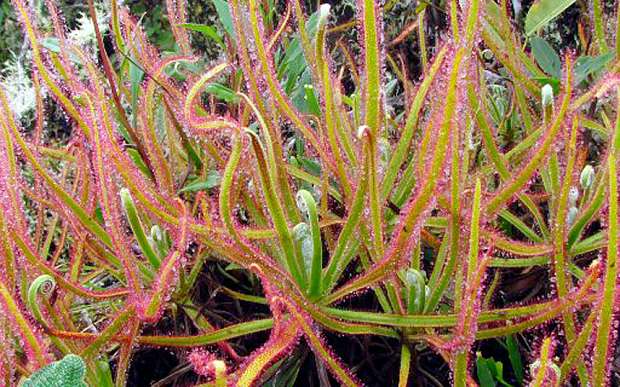August 3, 2015 weblog
Sundew discovery on Facebook makes plant science news

A new species of sundew has been discovered on Facebook. The find is a carnivorous sundew, Drosera magnifica. The new discovery comes from a single mountaintop in southeastern Brazil—the largest New World sundew.
Apart from size, other unusual features include a higher number of leaves per rosette, as well as their being broader. The new species was spotted by a person surfing the Internet.
"It was just another normal day on Facebook," Paulo Gonella, a doctoral student at the Universidade de São Paulo in Brazil, said in Discover. A friend who was a plant enthusiast had shared photos on the site, displaying plants in their natural habitat. Some of the sundews looked unusual to Gonella, much larger and unlike any of the other species in Brazil. He showed the picture to his colleague, and they set off for the mountaintop, to collect specimens and investigate more.
Among their investigation tasks would be to confirm data about the species—population size and potential threats to its habitat, to assess a conservation status.
"Most of the plants were at a single site on the south slope of the summit of Pico do Padre Ângelo between 1500 and 1530 m in elevation," wrote Christie Wilcox in Discover. Because of the shape of the mountain and wind patterns, the site is wetter than most around. The two investigators found the sundews in soil that was loose and sandy or even growing out of cracks in the sandstone surface. "As far as habitats go, it's not the most plant-friendly."
They later searched two other mountaintops close by the first but there was no sign of the new species. "D. magnifica is considered a microendemic and critically endangered due to the potential for extinction from habitat loss." They gave the species the word 'magnifica' because of the plant's "magnificent appearance," said Discover.
The species is considered Critically Endangered, according to the IUCN Red List categories and criteria.
Their study, "Drosera magnifica (Droseraceae): the largest New World sundew, discovered on Facebook," is by Paulo Minatel Gonella, Fernando Rivadavia, Andreas Fleischmann and it has been published in Phytoaxa, a journal of botanical taxonomy.
Their discovery is being talked about on a number of websites this week not just because of its botanical interest as a newly discovered species but also because where it was first discovered—on a massively used social media platform; such platforms are known for sharing less scientific items such as selfies on the beach or puppies tangled in baby blankets.
Discover made a point that Gonella is "one of a growing number of scientists who sees these sites a little differently."
"As a botanist, I see Facebook as an important tool," he said. "It allows me to be in touch with not only other fellow botanists, but also plant enthusiasts from all over the globe. I participate in a few plant identification groups, where people post photos of the plants they see in nature, and from these photographs, it is not rare for specialists to discover new regional records, new populations of rare plants and, now, new species."
In the paper, the three authors make a similar point: "Internet-based image databases have become an important tool for plant enthusiasts and botanists to share their interest and knowledge of species diversity and taxonomy. Photographs are publicly shared on internet discussion groups hosted by social networks, forums, and other websites, uniting amateurs and professionals in their common interests of plant identification and taxonomy, frequently resulting in the discovery of new regional records."
They said geographic location data enables further fieldwork by taxonomists, resulting in the formal report of discovery. "Here, we document the first plant species to be recorded as being discovered through photographs on a social network, a remarkable new species of sundew from Brazil."
More information: Phytoaxa, Vol 220, No 3. DOI: 10.11646/phytotaxa.220.3.4
© 2015 Tech Xplore


















